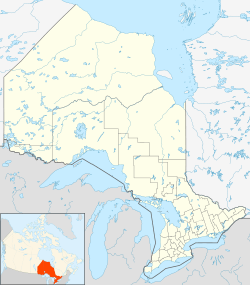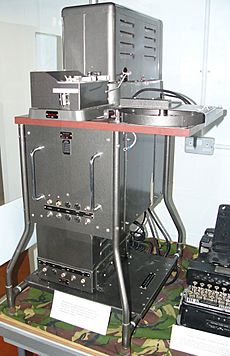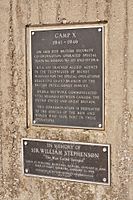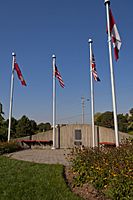Camp X facts for kids
Quick facts for kids
|
|
|---|---|
| Near Whitby, Ontario in Canada | |

Camp X in 1943
|
|
|
Shown within Ontario
|
|
| Coordinates | 43°51′15″N 078°53′06″W / 43.85417°N 78.88500°W |
| Type | Training installation |
| Site history | |
| Built | December 6, 1941 |
| In use | 1941–1969 |
| Fate | Destroyed |
| Garrison information | |
| Past commanders |
Sir William Stephenson, Lt. Col. Arthur Terence Roper-Caldbeck |
| Occupants |
|
Camp X was a top-secret training base during World War II. It was located in Ontario, Canada, near Whitby and Oshawa. This hidden camp taught secret agents special skills for dangerous missions behind enemy lines. Today, the area is called Intrepid Park. This name honors Sir William Stephenson, who was a key person in setting up this secret program.
The camp was run by the British Security Co-ordination (BSC) with help from the Canadian military, Foreign Affairs, and the RCMP. It also worked closely with MI6, Britain's spy agency. Camp X had a special radio station called Hydra. This station could send and receive secret messages around the world. The camp opened on December 6, 1941, and closed before the war ended in 1944. The buildings were taken down in 1969, and a monument now stands there.
Contents
What Was Camp X?
Camp X was created on December 6, 1941, by Sir William Stephenson. He was a Canadian from Winnipeg, Manitoba, and a trusted friend of leaders like Winston Churchill and Franklin Delano Roosevelt. The camp's first goal was to connect Britain and the US. At that time, the US was not yet officially in World War II.
The camp opened just before the attack on Pearl Harbor. Its main purpose was to train Allied agents from groups like the Special Operations Executive (SOE), Federal Bureau of Investigation (FBI), and American Office of Strategic Services (OSS). These agents were trained to go behind enemy lines as spies and saboteurs. Even before the US joined the war, American intelligence agents were interested in training at Camp X. Many agents from the FBI and OSS (which later became the Central Intelligence Agency, or CIA) secretly trained there in early 1942.
Sir William Stephenson was the first head of Camp X. The first leader of the camp was Lt. Col. Arthur Terence Roper-Caldbeck. Colonel William "Wild Bill" Donovan, who led the OSS during the war, said Stephenson taught Americans a lot about gathering intelligence. The CIA even named their own training place "The Farm," like the original farm at Camp X.
Training Secret Agents
Camp X was run together by the BSC and the Government of Canada. It had several secret names, like S 25-1-1 by the Royal Canadian Mounted Police (RCMP) and Project-J by the Canadian military. It was also known as Special Training School No. 103 by the Special Operations Executive.
What Was Taught?
Trainees at Camp X learned many secret skills. These included:
- How to destroy things (sabotage).
- How to cause trouble for the enemy (subversion).
- How to gather secret information (intelligence).
- How to pick locks.
- How to use explosives safely.
- How to use radios for secret messages.
- How to encode and decode messages.
- How to recruit people to help.
- How to fight without making noise (silent killing).
- How to fight without weapons (unarmed combat).
- How to use Morse code.
The camp was so secret that even the Canadian Prime Minister, William Lyon Mackenzie King, didn't know everything about it. Camp X also had a great facility for making fake documents. It trained many Allied secret agents. Estimates say that between 500 and 2,000 agents were trained there by the end of the war. These agents worked as spies, security personnel, or experts in psychological warfare. Many were captured and lost their lives, and survivors often received no public thanks for their bravery.
A key combat trainer was William E. Fairbairn, known as "Dangerous Dan." He taught agents to fight to win, no matter what. Another group at Camp X, called Station M, developed secret devices. While some stories say Station M was at Casa Loma in Toronto, this has been denied by historians.
One brave agent trained at Camp X was Gustave Biéler. He worked with the French Resistance in Northern France. His group destroyed railways, bridges, and enemy supplies before the D-Day invasion. He was captured and executed by the Nazis in 1944.
After the US joined the war, the OSS started its own special training programs. These programs were based on what they learned at Camp X.
The Hydra Communications Hub
One very important part of Camp X was Hydra. This was a very advanced radio station set up in May 1942 by engineer Benjamin deForest Bayly. Bayly also invented a super-fast machine called the Rockex (or "Telekrypton"). This machine helped to quickly code and decode secret telegraph messages.
Hydra was located on the shore of Lake Ontario. This spot was perfect for receiving radio messages from Europe and South America. It was also a safe place to send and receive secret codes because of the land around it. News reports say that "HAM Operators" at Camp X used transmitters to send and receive coded messages to and from Britain and behind enemy lines.
Hydra sent and received Allied radio signals from all over the world. The Canadian government later said that Hydra was a vital part of the larger Allied radio network. It helped send secret information safely between Canada, Great Britain, other Commonwealth countries, and the United States.
The Hydra station was very useful for coding and decoding information safely. It kept messages hidden from German spies. Hydra also had direct phone and telegraph lines to Ottawa, New York City, and Washington, D.C.. The main transmitter used at Hydra was originally from an American radio station. Other radio equipment was bought secretly from amateur radio fans and put together at the camp. After being used by the Canadian Forces during the Cold War, the transmitter was taken apart in 1969.
After the War
Some famous people may have visited or trained at Camp X. One person often mentioned is Ian Fleming, who later wrote the James Bond books. However, there is some debate about whether he actually trained there. The character of James Bond was partly inspired by real spies like William Stephenson.
Children's book author Roald Dahl and British writer Paul Dehn also trained at the camp.
After Camp X closed, it was used by the RCMP starting in 1945. It became a secure place to interview Igor Gouzenko. He was a Soviet spy who had left his job and told Canada about a big Soviet spy network. Gouzenko and his family stayed at the camp for two years.
Later, until the buildings were destroyed in 1969, the camp was called the Oshawa Wireless Station. It was a secret listening post for the Royal Canadian Corps of Signals. Any records that were not destroyed were kept secret under the Official Secrets Act. The site is now a public park called "Intrepid Park" in Whitby, Ontario. Each year, 2 Intelligence Company, a military intelligence unit, holds Remembrance Day ceremonies there.
In 2016, a damaged building from Camp X was found and was being fixed. People still find old items from the spy camp in the park. In August 2016, someone found a rusty World War II smoke mortar round with a metal detector. This led to a visit from a bomb disposal team.
Memorial
A special plaque at Intrepid Park remembers the secret school and the important Hydra communications center. Another plaque honors Sir William Stephenson.
Camp X in Movies
Camp X has been shown in movies and TV shows. These include the CBC series X Company, which ran from 2015 to 2017. The History Channel also made a documentary called Camp X: Secret Agent School in July 2014. This documentary showed recreated scenes and interviews with people who were connected to the camp.






